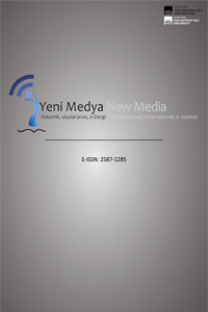YÖNETMENİN KURGUSUNDAN HAYRAN KURGUSUNA: DİJİTAL SİNEMA ÇAĞINDA YÖNETMENİN YARATICI KONUMU VE AUTEUR KURAM
Sinema tarihinin özellikle Birleşik Devletler’de ve Avrupa’daki macerası göz önünde bulundurulduğunda farklı tarihsel süreçlerde özellikle yönetmenin konumu açısından film yapım şirketlerindeki profesyonel bir çalışandan yaratıcı kişiliğini filmlere yansıtan bir sanatçıya doğru geçirdiği dönüşüm takip edilebilmektedir. İçinde bulunulan dijital kültür çağında ise dijital teknolojilerin film yapım maliyetlerini azaltarak daha ulaşılır olması, buna zıt şekilde büyük bütçeli Hollywood filmlerinin endüstrideki başat konumu, film yapım maliyetlerindeki yükseliş, film yapım sürecinde iş akışının değişmesi, seyircinin filmlerin tüketicisi konumundan üreten tüketiciye doğru geçirdiği değişim gibi nedenler sinema filmlerinin yaratım sürecinde daha fazla sayıda kişinin katkısını gerektirmiştir. Bu anlamda auteur yönetmen ve yönetmenin bir sanatçı olarak filmin yaratıcısı olma konumu da dijital sinemayla birlikte bir kez daha tartışmaya açılmıştır. Çalışmada dijitalleşmenin sinema kuramlarında yarattığı potansiyel dönüşümün özellikle auteur kuram açısından dijital sinema ekolojisi, hayran kültürü ve kolektif üretime dayalı yaratıcılık bağlamında ortaya konulması amaçlanmaktadır. Bu doğrultuda makalede Youtube’da 1997 yapımı Titanik (James Cameron) filmi üzerine yapılan hayran üretimleri incelenmiş, katılımcı kültürün etkisiyle özellikle hayran kültürünün film, yaratıcı süreç ve filmlerin anlamlandırılması arasındaki ilişkiyi köklü biçimde dönüştürdüğü sonucuna ulaşılmıştır.
Anahtar Kelimeler:
Dijital sinema, Auteur kuram, Hayran Kültürü, Katılımcı Kültür
From Director's Cut to Fan Fiction: The Creative Position of the Director and Auteur Theory in the Age of Digital Cinema
Considering the adventure of the history of cinema, especially in the United States and Europe, in different historical processes, especially in terms of the position of the director, the transformation from a professional employee in film production companies to an artist who reflects his creative personality on films can be followed. In the current era of digital culture, the reasons such as the fact that digital technologies are more accessible by reducing film production costs, on the contrary, the dominant position of big-budget Hollywood films in the industry, the rise in film production costs, the change in the workflow in the filmmaking process, the change of the audience from the consumer of the films to the producer. required the contribution of more people in the creation process of motion pictures. In this sense, the position of the auteur director and the director as the creator of the film as an artist has once again been opened to discussion with digital cinema. In the study, it is aimed to reveal the potential transformation created by digitalization in cinema theories, especially in terms of auteur theory, in the context of digital cinema ecology, fan culture and creativity based on collective production. In this direction, the fan productions on the 1997 movie Titanic (James Cameron) on Youtube were examined in this article, and it was concluded that with the influence of participatory culture, especially the fan culture radically transformed the relationship between film, the creative process and the making of films.
Keywords:
Digital Cinema, Auteur Theory, Fan Culture, Participatory Culture,
___
- Kuyucak Esen, Ş. (2013). Sinemada auteur kuramı. Z. Özarslan (Ed.). Sinema kuramları 2: Beyaz perdeyi aydınlatan kuramlar içinde (s. 33-50). Su Yayınevi.
- Manovich, L. (2021). Dijital sinema nedir? S. Denson ve J. Leyda (Ed.). Post sinema: 21. Yüzyıl sinemasının kuramsallaştırılması içinde (s.31-57). NotaBene Yayınları.
- Monaco, J. (2006). Yeni dalga. (E. Yılmaz, Çev.). +1 Kitap.
- Başlangıç: 2016
- Yayıncı: Ankara Hacı Bayram Veli Üniversitesi
Sayıdaki Diğer Makaleler
Hicran Özlem ILGIN, Damla KARAGÜL
Fatma Kübra ASTAM, Süleyman Hakan YILMAZ
Beden Odağında COVID-19 Salgını: Dijitalleşme, Gözetim ve Öz-takip
Afet İletişimi, Politik Tüketim ve Sosyal Medya: 6 Şubat Kahramanmaraş Örneği
Burçe AKCAN, Mustafa MERDİN, Merve GENÇYÜREK ERDOĞAN
Instagram Kullanıcılarının Gözetim Farkındalıklarının Ortaya Konulmasına Yönelik Nitel Bir Çalışma
Metaverse’e Yönelik Kullanıcı Algıları: Yeniliklerin Yayılımı Kuramı Bağlamında Nitel Bir İnceleme
